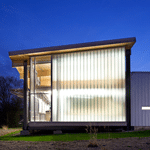Iowa City is a river city. Just as the flood plains are replenished each time the Iowa River runs high, the city adapts and develops with its ever-changing population of educated, eco-conscious residents. Unlike other urban centers in Iowa, the city is home to one of the state’s flagship universities, as well as a peculiar combination of young and old who demand progress from their city and each other. While the rest of the country knows them by their cash crop—corn—the locals take pride in their farmer’s market, which heads into its 41st season this May. The city is growing in rare defiance to the national trend of recession, but it is not without its challenges. Rather than shy away from opportunity, the city has faced it with three new trendsetting innovations.
lookING out for families
The US Census has approximately three-fourths of Iowa City’s more than 68,000 residents at ages between 18 and 65. This makes for a competitive housing market, especially close to the University of Iowa, where a handful of college students can outbid a family of five. Community development coordinator Steve Long and a team from the city recognized this as an exceptional problem that required a unique solution.
The UniverCity Neighborhood Partnership is a counterweight to the tipping scales of home ownership. The city and the university teamed up to launch a letter campaign gauging the interest of more than 450 landlords in selling their properties to the city. With an overwhelmingly positive response, a committee toured 100 homes—varying in level of upkeep—and purchased 26.
Materials salvaged from homes torn down after the 2008 flood helped alleviate costs, but in order to stay within budget, the city couldn’t spend more than $250,000 on the purchase and renovation of each home, so efficiency and safety were top priorities.
As Long and his team began gutting and buffing the historic gems back into shape, they started to notice contractor’s trucks parked alongside their own and ladders leaning against neighboring houses. It turned out the remodeling was contagious, Long says, and ended up spurring the transformation of entire blocks. In some places, where neighbors have kept to themselves for years, block parties are now sprouting.

<b>DETAILS Iowa City Free Clinic</b>
The Iowa City Free Clinic provided services to almost 2,500 people throughout the 2010-2011 fiscal year, in a new, sustainable building that incorporates environmentally friendly and readily renewable materials.
housing and health care
Two of the city’s most recent civic investments directly benefit the group that perhaps needs them most. The Aniston Village Limited Partnership project and the Iowa City Free Medical Clinic were designed to transfer all the benefits of superior green design to the city’s income-sensitive residents without passing on an economic burden.
From its proximity to amenities and resources to the color of the sidewalks, Aniston Village was planned to be as efficient and ecologically responsible as possible. The 22-home project, designed by architect John Shaw, AIA, LEED AP, is a noteworthy innovation, even for progressive Iowa City. With more than 60 various features that benefit residents and the environment, Aniston Village should earn high marks for its low impact when certification time comes around. The proof was in the utility bills when Shaw’s water-conserving appliances and highly resistant thermal envelopes were put to the test. After their first winter, the handsome homes are seeing remarkably low energy costs.
The Iowa City Free Clinic didn’t have the advantage of being designed from scratch, and its 45-year-old frame had to be considered. “There’s an old saying,” says Shaw, “that the greenest building is an existing building.” By overhauling the façade and envelope—which included the use of zinc and aluminum, high-performing windows, and LED lighting—Shaw was able to optimize space and minimize waste.
“This renovation has extended the useful life of the building,” Shaw says. “Had it been demolished, the embodied energy that went into the original structure would have been lost, and its materials would have gone in the landfill.”

DETAILS East Side Recycling Center
The East Side Recycling Center has fulfilled its mission since breaking ground on day one. When abandoned farm equipment, tires, and the axle of a pickup truck were found embedded at
the project site, the team disposed of materials responsibly, avoiding the local landfill. Since then, the center has become more than just a recycling center; it’s a multipurpose drop-off and salvage site, as well as a community classroom. Targeting LEED Platinum certification, the building hovers over the ground to reduce the impact on the bioswale surrounding it, and project architect Shive-Hattery even added skylights in the restrooms to fuel the solar-powered sinks.
AN East SIDE green outpost
In 2010, Iowa City was chosen by the EPA as one of five communities in the United States to receive assistance in revitalizing its brownfield areas, and coupled with dozens of nonprofits and a rapidly filling landfill, the city was primed for change.
Enter Shive-Hattery, with a plan for a comprehensive reuse-and-recycling center that would double as a classroom and LEED-certified landmark for the community. Besides handling a portion of the city’s recycling operations, the recently completed East Side Recycling Center also houses a drop-off center for electronics and oil, a salvage barn for building materials, a furniture-exchange facility, a pick-up for compost, storage for salt and sand, and a water-distribution station.
The entire facility is powered by clean energy and not a watt is lost on the lighting and plumbing fixtures, which are outfitted with occupancy sensors and automatic shut-off and flushing mechanisms. Solar panels power the south-facing sunscreens, and wind energy generated on-site contributes five percent of the building’s power. “In a city that’s very well-educated and concerned about environmentalism,” says Shive-Hattery architect Mark Seabold, “this gives the public a beautiful campus to centralize those ideas.”

